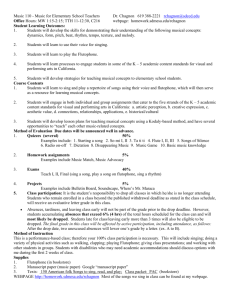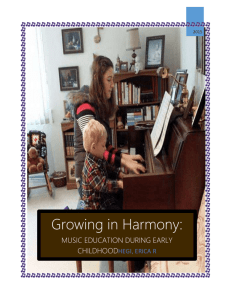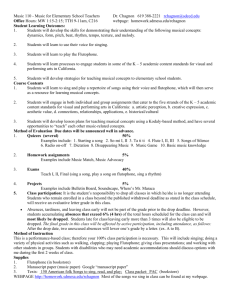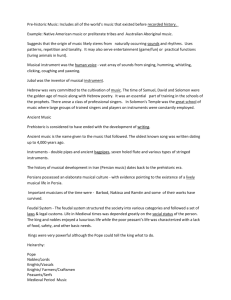Form
advertisement
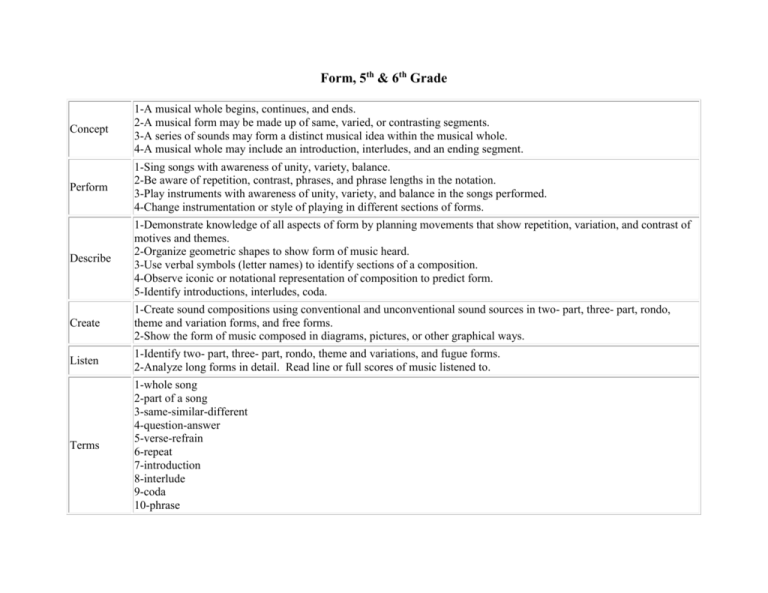
Form, 5th & 6th Grade Concept 1-A musical whole begins, continues, and ends. 2-A musical form may be made up of same, varied, or contrasting segments. 3-A series of sounds may form a distinct musical idea within the musical whole. 4-A musical whole may include an introduction, interludes, and an ending segment. Perform 1-Sing songs with awareness of unity, variety, balance. 2-Be aware of repetition, contrast, phrases, and phrase lengths in the notation. 3-Play instruments with awareness of unity, variety, and balance in the songs performed. 4-Change instrumentation or style of playing in different sections of forms. Describe 1-Demonstrate knowledge of all aspects of form by planning movements that show repetition, variation, and contrast of motives and themes. 2-Organize geometric shapes to show form of music heard. 3-Use verbal symbols (letter names) to identify sections of a composition. 4-Observe iconic or notational representation of composition to predict form. 5-Identify introductions, interludes, coda. Create 1-Create sound compositions using conventional and unconventional sound sources in two- part, three- part, rondo, theme and variation forms, and free forms. 2-Show the form of music composed in diagrams, pictures, or other graphical ways. Listen 1-Identify two- part, three- part, rondo, theme and variations, and fugue forms. 2-Analyze long forms in detail. Read line or full scores of music listened to. Terms 1-whole song 2-part of a song 3-same-similar-different 4-question-answer 5-verse-refrain 6-repeat 7-introduction 8-interlude 9-coda 10-phrase 11-section 12-pattern 13-cadence-home tone 14-AB form 15-Call-response 16-repetition-contrast 17-phrase 18-repeat sign 19-ABA 20-rondo 21-theme and variations 22-motive 23-march 24-suite 25-march 26-opera 27-aria 28-recitative 29-ABACA 30-A A' A" etc. 31-sonata 32-symphony 33-concerto 34-tone poem 35-phrase 36-section 37-movement 38-DC al fine 39-DC al segno 40-Fine 41-sonata and allegro Icon/Symbol Harmony/Texture, 5th & 6th Grade Concept 1- A series of simultaneous sounds may alternate between activity and rest. 2- Two or more musical lines may occur simultaneously 3- Few or many musical lines may occur simultaneously. 4- Chords and melody may move simultaneously in relation to each other. 5- Musical quality is affected by the distance between simultaneously sounded musical lines. 6- Musical quality is affected by the number of and degree of contrast between musical lines sounding simultaneously. Perform 1- Sing music that has melody alone, melody in canon, melody with countermelodies, melody with harmonic accompaniment, melodies with countermelodies and accompaniment. 2- Play melodies on recorders, bells, or barraphonic instruments alone, in canon, with ostinato patterns, with harmonic and rhythm accompaniment. 3- Play harmonic accompaniment by chording or on the cuitar, autoharp, or piano. 4- Sing songs in rounds, with ostinato, chants, with partner songs, and with descants. Describe 1- Devise visual representations that demonstrate awareness of multiple lines within a musical score and/or chordal changes in accompaniment. 2- Demonstrate awareness of chord changes by changing movement. 3- Identify verbally the distinctive sound of the I, IV, and V7 chords when heard as chordal accompaniment to melody. 4- Compare and contrast differences in textures using verbal terms such as thick-thin, close together-far apar, or show visual representations. 5- Verbally identify music heard as homophonic, polyphonic, or monophonic and define differences. Create 1- Create ostinato patterns, countermelodies, rhythm accompaniments, and harmonic accompaniments by using conventional chords and sounds or by experimenting withtone clusters, chords in seconds or fourths. 2- Create compositions in two, three, four or more voiced texture. 3- Create ostinatos, descants, and harmony parts for songs sung or played. 4- Create ostinatos, descants, rounds, and harmony parts for sound compositions. Listen 1- Identify music that is monophonic, polyphonic, homosphonic, or that alternates between homophonic and polyphonic texture. 2- Identify the number of voices in a texture. 3- Identify fugues and canons. 4- Listen with awarenessof the expressive effect of texture and tone color, especially as combined. 5- Identify the expressive effect of different kinds of harmonies: consonant, dissonant, simple, and complex. Terms 1- accompany 2- accompaniment 3- chord, chord symbols 4- ostinato 5- round 6- canon 7- I chord 8- IV chord 9- V chord 10- thick/thin 11- heavy/light 12- getting thinner 13- getting thicker 14- tone color 15- monophonic, monophony 16- polyphonic, polyphony 17- homophonic, homophony 18- major 19- minor 20- unison/harmony 21- descant 22- solo 23- tutti Icon/Symbol Melody, 5th & 6th Grade Concept 1- A series of pitches may move up, down, or remain the same. 2- A series of pitches may move up or down by steps or skips. 3- Each pitch within a melody oves in relation to a home tone. 4- A series of pitches bound by the same octave "belong together," forming a tonal set. 5- A melody may be relatively high or low. 6- Individual pitches, when compared to one another, may be higher, lower, or the same. 1- Sing melodic contours accurately within the range: Perform 2- Sing with awareness of sequential patterns. 3- Sing melodies from notation, using numbers, note names, and sol-fa syllables with hand signals. 4- Sing music that moves scalewise or by leap accurately, identifying intervals. 5- Sing melodies with an awareness of tonal basis and of shifting tonal basis. 6- Write scales for songs performed. 7- Sing with awarenesso f phrase and cadence. 8- Sing songs within range of voices. Be aware of contrast of register and range. 9- Play melodies on recorder, uitar, bells by ear, from notation by note names, and by numbers. 10- Play recorder melodies using simple chromatic alterations (B-flat, F-sharp, C-sharp). 11- Play melodies on pitched instruments, identifying skips and steps on the instruments and in the notation. 12- Play melodies with awareness of tonal center. Build various scales on bells and instruments. 13- Play instruments with awareness of phrase structure and cadences. 14- Play melodies in high and low ranges, with wie and narrow range with awareness of effect of register and range on playing technique. Describe 1- Continue to use body scale or improvised movement to demonstrate awareness of step-skip, tonality. 2- Use appropriate terms (including letter names) to identify key, tonality, and modality when hearing music or observing musical score. Create 1- Create melodies in all possible media and notate, using graphic or conventional notation. 2- Improvise melodies freely. 3- Create melodies that have conjuct or disjunct motion for expressive effect. 4- Improvise or create melodies on various tonal bases to achieve expressie effects. Notate melodies in conventional or graphic notation. 5- Create melodic phrases with clearly defined structure. 6- Create melodies in registers and with wide and narrow range to achieve expressive effect. Listen 1- Identify melodic contours by ear, by using graphic notation and diagram, and by using conventional notation. 2- Identify conjunct or disjunct motion in melodies of music listened to. Show the motion in diagrams or graphic notation. 3- Identify melodies based on major, minor, pentatonic, whole-tone, chromatic, shifting major-minor scales, and melodies that are atonal. 4- Identify melodic motives, phrases, and cadences. 5- Identify register and ranges of melodies listened to. Terms Icon/Symbol 1- going up 2- going down 3- staying the same 4- step 5- skip 6- leap 7- high, higher 8- low, lower 9- same 10- hometone 11- treble clef 12- bass clef 13- melody 14- melodic shape 15- tonal center 16- major scale 17- minor scale 18- sharp 19- flat 20- natural 21- chromatic scale 22- key 23- intervals 24- key signatures Rhythm, 5th & 6th Grade Concept 1-Music may be comparatively fast or slow, depending on the speed of the underlying pulse. 2-Music may become faster or slower by changing the speed of the underlying pulse. 3-A series of pulses may be organized into regular or irregular groupings by stressing certain pulses. 4-Individual sounds and silences within a rhythmic line may be longer than, shorter than, or the same as other sounds within the line. 5-Individual sounds and silences within a rhythmic line may be longer than, shorter than, or the same as the underlying pulse. 6-A series of sounds may move from one to the next in either a smoothly connected or a detached manner. 7-Accented sounds within a rhythmic line may sound with, before, or after the stressed underlying beat. 8-The quality of a sound is affected by the way the sound begins, continues, and ends. Perform 1- Sing with awareness of steady beat 2- Sing with appropriately fast, slow, and changing tempos 3- Sing melodies, stressing accented beats. 4- Sing with awareness of meters in two, three, four, five, six, seven, eight, nine. 5- Sing songs, reading rhythmic notation in all meters. 6- Sing songs, identifying repeated and contrasting rhythm patterns. Sing, reading rhythm notation with all note and rest values and tied notes. 7- Sing syncopated patterns. Identify and read the syncopated patterns from notation. 8- Sing and play withlegato, staccato, marcato style, as appropriate in response to markings found in music. 9- Play instruments, showing steady beat. 10- Play instruments at appropriate fast, slow, and changing tempos. 11- Play with awareness of meter in two, three, four, five, six, seven, eight, and nine. 12- Play rhythm accompaniments from notation, reading rhythmic notation in all meters. 13- Play rhythm patterns, reading all note and rest values and tied notes in conventional notation. 14- Play both simple and complex rhythm patterns in accompaniments, in songs, and in rhythm compositions. 15- Play syncopated rhythm patterns on pitched and nonpitched instruments by ear and notation. Describe 1- Demonstrate recognition of complex rhythms by translating them into iconic representation. 2- Use notes and/or icons to describe rhythm of melodies heard, using four lengths of sound or silence including durations that move in 3-1 relationships. 3- Use rhythm ruler to show length of individual durations in relation to underlying pulse and meter. 4- Verbally identify meter, including asymmetric groupings, and tempo markings. 5- Use movement to show recognition of asymmetric meters. 6- Use icons and/or movement to show differences in articulation when listening to music. 7- Verbally identify symbols that specify articulation within the musical score. Create 1- Create music that demonstrates steady beat and absence of beat (succession of sounds). 2- Create sound compositions, using tempo for expressive effects. 3- Create musical sound pieces, using unusual or changing meters as the principal idea. 4- Notate compositions in graphic and conentional notation. 5- Create sound pieces having repeated and contrasting rhythm patterns. Create sound pieces having simple and complex rhythm patterns. Notate compositions with simple patterns in conventional notation. 6- Create sound compositions that have syncopated rhythm patterns. Notate the patterns graphically or in conventional notation. Listen 1- Identify music that has a steady beat or no beat. 2- Identify tempos and their expressive effect. 3- Identify tempos and their expressive effect. 4- Identify music that has meters of two, three, four, five, six, seven, and nine. Identify changing meters in music. 5- Identify same, different rhythm patterns. Identify simple and complex rhythm patterns in music listened to. 6- Identify syncopated rhytms in music listened to. Terms 1- Fast-slow 2- Faster-slower 3- shortest sound 4- tempo 5- steady beat 6- short-long 7- shorter than 8- longer than 9- same as 10- different 11- similar 12- heavy-light 13- sound-silence 14- smooth-bouncy 15- twice as long 16- half as long 17- rhythm of the melody 18- twos 19- threes 20- eighth note/rest 21- quarter note/rest 22- half note/rest 23- tie/slur 24- meter signature 25- legato 26- staccato 27- marcato 28- underlying steady beat 29- pulse 30- tempo 31- adagio 32- largo 33- andante 34- allegro 35- presto 36- ritard 37- accelerando 38- three times as long 39- slur 40- names of common notes and rest 41- sustained 42- detached 43- slurred Icon/Symbol Style/Time and Place, 5th & 6th Grade Concept 1-The way musical elements are combined into a whole reflects the origin of the music. 2-The origin of music is reflected in the way timbre, dynamics, articulation, rhythm, melody, harmony, tempo, and texture are interwoven within the musical whole. Perform 1-Sing music in various ethnic styles with correct phrasing and vocal sound. 2-Sing pop music, music of classical, romantic, and contemporary eras with appropriate style. 3-Be aware of different styles in singing. 4-Play appropriate instruments with correct technique and stylistic ideas for various ethnic styles. Describe 1-Perform dances reflective of particular styles, matching movement to form of song. 2-Use appropriate labels to identify origin (particular culture or era) of music heard. 3-Verbally give reasons for assigning music heard to a particular culture or historical era based on present level of understanding of contribution of particular elements. 4-Use appropriate labels to identify music of particular culture of era and discuss ways specific elements are used in music of different times and places. Create 1-Create music using techniques of various ethnic styles: blues, calypso, country, etc. 2-Improvise on guitar in various scales: major, minor, pentatonic, and blues scales. Listen 1-Identify music of various ethnic styles and determine stylistic characteristics. 2-Identify and determine characteristics of baroque, classical, romantic, and modern styles. 3-Identify and determine characteristics of various jazz, blues, and popular styles in music listened to. 4-Discriminate between same and different styles between kinds and within kinds of music. Terms 1-Long ago 2-Far away 3-Lullaby 4-March 5-Name of country/culture of origin. 6-Labels associated with common contemporary groups: bluegrass, jazz, country, rap, etc. Icon/Symbol Timbre/Dynamics, 5th & 6th Grade Concept 1- Music may be comparatively loud or soft. 2- Music may become louder or softer. 3- The quality of a sound is determined by the sound source. 4- The quality of a sound is affected by the material shape, and size of the source. 5- The quality of a sound is affected by the way the sound is produced. 6- The quality of a sound is affected by the number and qualities of sounds occuring at the same time. 7- Sound sources include body, vocal, and environmental. Perform 1- Sing, observing appropriate dynamic levels. Shape phrases with dynamic variation. Observe dynamic markings in score when singing. 2- Play appropriate instruments at an appropriate dynamic level when accompaying or playing songs and rhythm compositions. Observe dynamic markings in the score. 3- Sing with appropriate tone color for expressiveness. 4- Play instruments of appropriate tone color for acoompanying songs. 5- Play instruments, using correct technique, for achieving the best sound. 6- Experiment with techniques to find new sounds on instruments. Describe 1- Verbally describe changes in dynamics using appropriate image terms as well as selected verbal symbols. 2- Identify symbols in musical score that specify dynamics. 3- Categorize instruments according to family, using correct terminology. 4- Explain reasons for difference in timbre ased on understanding of effect of size, material, shape, and method of production. 5- Identify common ensembles including contemporary and those from various cultures. Create 1- Explore dynamic possibilities of sound sources. Include appropriate dynamic markings in sound compositions. Explore expressive possibilities of dynamic variation. 2- Experiement with the following to find new sources for sound compositions. ---vocal dounds ---body sounds ---room sounds ---"found" instruments in the home, shop, or school ---all classroom instruments 3- Experiment with words and chants. 4- Experiment with tape recordings to preserve and combine sounds in sound compositions. Listen 1- Identify expressive effect of dynamic variation in music lestened to. 2- Identify tone color of instrument families, individual orchestra and band instruments, the synthesizer, piano, organ, harpsichord, and ethnic instruments. Terms 1- loud 2- forte 3- mezzo forte 4- fortissimo 5- soft 6- piano 7- mezzo piano 8- pianissimo 9- getting louder 10- crescendo 11- getting softer 12- decrescendo 13- qualities associated with sounds of instruments: ringing, thumping, etc. 14- voices: male, female Instruments: Classroom and selected band & orchestra 15- guitar 16- piano 17- organ 18- synthesizer Orchestra families 19- strings 20- woodwinds 21- brass 22- percussion Ensembles 23- band 24- orchestra 25- choir 26- rock band 27- jazz combo 28- jazz ensemble 29- mariachi band 30- gamelan 31- steel band 32- duet 33- trio 34- quartet 35- quintet 36- chordophones 37- membranophones 38- idiophones 39- aerophones 40- electrophones Icon/Symbol


